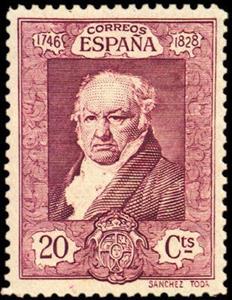Stamp: Age of Goya, Seville Exhibition (Spain 1930)
Age of Goya, Seville Exhibition (Spain 1930)
01 January (Spain ) within release Quinta de Goya in the exhibition of Seville goes into circulation Stamp Age of Goya, Seville Exhibition face value 20 Spanish céntimo
| Stamp Age of Goya, Seville Exhibition in catalogues | |
|---|---|
| Michel: | Mi:ES 472 |
| Yvert et Tellier: | Yt:ES 417 |
| Edifil: | Edi:ES 506 |
Stamp is square format.
Also in the issue Quinta de Goya in the exhibition of Seville:
- Stamp - Age of Goya, Seville Exhibition face value 1;
- Stamp - Age of Goya, Seville Exhibition face value 4;
- Stamp - Age of Goya, Seville Exhibition face value 5;
- Stamp - Age of Goya, Seville Exhibition face value 20;
Stamp Age of Goya, Seville Exhibition it reflects the thematic directions:
Commemorations are a type of religious observance in the many Churches of the Anglican Communion, including the Church of England. They are the least significant type of observance, the others being Principal Feasts, Principal Holy Days, Festivals, and Lesser Festivals. Whereas Principal Feasts must be celebrated, it is not obligatory to observe Commemorations. They are always attached to a calendar date, and are not observed if they fall on a Sunday, in Holy Week, or in Easter Week. In Common Worship Commemorations are not provided with collects or indications of liturgical colour. However, they may be celebrated as Lesser Festivals if local pastoral conditions suggest it.
Painting is the practice of applying paint, pigment, color or other medium to a solid surface (support base). The medium is commonly applied to the base with a brush, but other implements, such as knives, sponges, and airbrushes, can be used. Painting is a mode of creative expression, and the forms are numerous. Drawing, gesture (as in gestural painting), composition, narration (as in narrative art), or abstraction (as in abstract art), among other aesthetic modes, may serve to manifest the expressive and conceptual intention of the practitioner. Paintings can be naturalistic and representational (as in a still life or landscape painting), photographic, abstract, narrative, symbolistic (as in Symbolist art), emotive (as in Expressionism), or political in nature (as in Artivism). A portion of the history of painting in both Eastern and Western art is dominated by spiritual motifs and ideas. Examples of this kind of painting range from artwork depicting mythological figures on pottery, to Biblical scenes rendered on the interior walls and ceiling of the Sistine Chapel, to scenes from the life of Buddha or other images of Eastern religious origin. In art, the term painting describes both the act and the result of the action. The support for paintings includes such surfaces as walls, paper, canvas, wood, glass, lacquer, clay, leaf, copper and concrete, and the painting may incorporate multiple other materials including sand, clay, paper, plaster, gold leaf, as well as objects. The term painting is also used outside of art as a common trade among craftsmen and builders.


